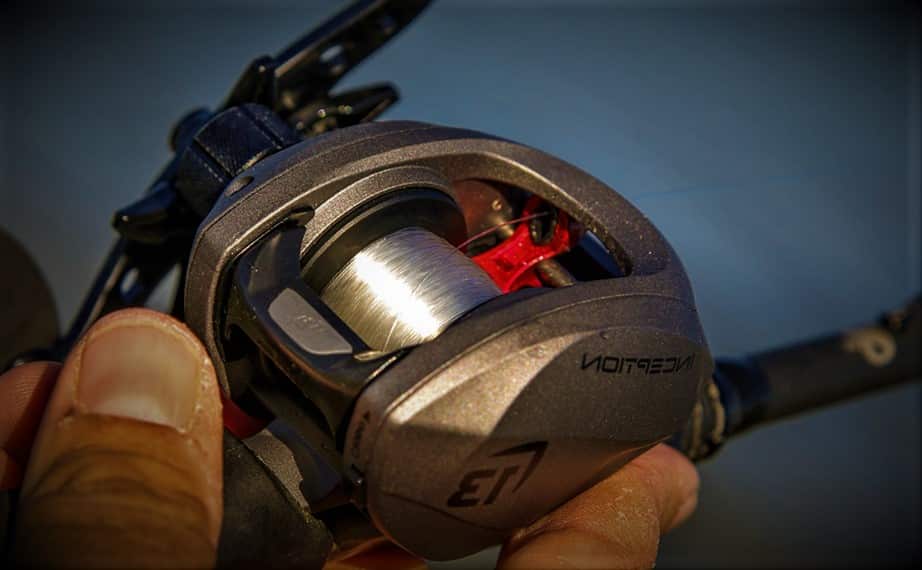Reeling in fish is easier said than done. When a fish feels the hook it will do everything it can get free. This will include everything from jumping to making a long run on your line. They may even throw in a few other obstacles here and there. Each species is going to react differently being on your line. In shallow water they’re much more likely to jump around whereas deepwater fish have a tendency to go to the bottom. Without knowing the proper technique you’re sure to lose out a few great fish.
How To Reel in Fish Quickly
Before Setting The Hook
Before setting the hook and reeling in your fish you’re going to want to properly set up the drag. The easiest way to set your drag is to use a digital fishing scale. Digital fishing scales allow you to quickly pinpoint the correct drag setting reducing your risk of line slippage.
First Set The Hook
As soon as you feel the fish on your line you’re going to want to set the hook. To set the hook simply snap the tip of the rod up. By successfully hooking the fish in the mouth you’ll have a better chance of landing a large fish. All the movement is done in your wrist and elbow. Try not to lift the rod up completely over your head.
- Setting the hook too soon or too late will most likely result in a lost fish. Setting the hook too soon pulls the lure out of the fish’s mouth. Setting the hook too late allows the fish to swallow the hook. This could result in a gut hook that’s difficult to remove.
- Try and choose the correct hook size for the fish you’re going after. Too small of a hook won’t fully penetrate the fish’s mouth whereas a large hook could possibly tear out of its side.
How to Properly Reel in Fish
Not every fish is going to be as simple as just reeling in your line. That might work on smaller panfish like bluegill and crappy, but you’ll have a lot more trouble catching that trophy bass. Bigger fish are going to pull harder and be a real challenge to reel in. That’s the fun of competitive fishing.
So how do you know the size of your fish before reeling it in? When the fish starts pulling off your line while you’re holding it tightly, it’s probably a big catch. You will be able to tell by the sound of the reel letting out line. This is where most beginners start to make mistakes. One of the most important parts of landing a fish is knowing when to reel. Reeling too early may lose the fish before the hook is properly set.
- When the fish starts to pull out the line let the rod do the work for you. Just relax and let the drag and reel let out the line. Leave your rod floating at a 45° angle aiming straight at the fish. Whenever you feel the drag stopping get ready to reel.
- Once the fish finally starts to slow down and it’s no longer taking out line, it’s time to bring in the fish. When learning how to bring in fish you should try pumping the rod and starting the reel.
- Before you start to reel in the fish bring your rod up to the sky. Try and pull it up completely vertical and get ready for the fish to respond. Most large fish are going to quickly respond by putting a major bend in your rod. This is completely normal and normally means the fish is going to be large.
- As you start to lower the tip of your rod begin to slowly reel in. Bring the tip of your rod back down to the ready position of approximately 45°. Try to keep an even pressure on the fish and repeat the process as many times as necessary.
Quick Tips
- Make sure you set the drag properly before you have a fish on the hook. The easiest way to set the drag is to use a digital fishing scale. Just pull down on the line until the drag begins to slip and take the measurement on the scale. Adjust the drag mechanism until you get a reading you like
- Keep your rod tip up between 45° and vertical keeping the line tight.
- When reeling in the fish try and keep it away from anything that can snag your line. Try and steer the fishes had by moving the rod from side to side. When the fish starts to run towards you reel in your line and stop once it moves away.
Pumping The Fish
Pumping the fish is as simple as pulling the reel in towards you to bring the fish closer to your line. It will allow you to reel in the slack without creating excess drag. Pumping the fish is as simple as following three basic commands.
- Let the rod tip up pulling the fish towards you.
- Lower the rod tip allowing some slack in the line.
- When there’s slack in the line quickly reel and repeat the process.
Landing The Fish
All landing the fish means is getting it out of the water. The best way to land a fish is to use a fishing net. Using a fishing net protects the fish and helps improve success. To use and that you’re going to want to completely wear out the fish until it’s close to the dock, boat or shore. Just place the net into the water and steer the fishes head into the net. Chasing the fish around will most likely cause it to flee and risks losing the fish.

